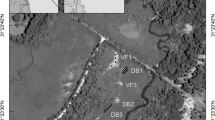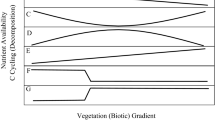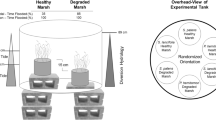Abstract
We measured daily precipitation, duration of ponding and soil redox potential for 2 years in three coastal prairie sites near the mouth of the Rio Grande in south Texas. The area historically was dominated by gulf cordgrass, Spartina spartinae. Much of the area was plowed for agriculture and Spartina has not recolonized disturbed sites. Regulation of the Rio Grande has eliminated flooding and disconnected the study area from the river. The goal of this project was to use continuous measures of water levels and soil redox potential to determine whether the study areas have a wetland hydrologic regime. Anoxic soils formed and persisted for at least 2 weeks only following hurricanes or large tropical storms that produced at least 15 cm of precipitation over 1–3 days and created ponding. Over the past century storms of this magnitude occurred only 1 out of 4 years. This study determined that the study sites do not support wetland hydrologic regimes due to river regulation, however reestablishment of the dominant wet prairie species is possible through planting.




Similar content being viewed by others
References
American Public Health Association (2005) Standard methods for the examination of water and wastewater, 21st edn. American Public Health Association, Washington
Batzer DP, Sharitz RR (2006) Ecology of freshwater and estuarine wetlands. University of California Press, Berkeley, 568p
Clover GU (1937) Vegetational survey of the lower Rio Grande Valley, Texas. Madrono 4:41–127
Dynesius M, Nilsson C (1994) Fragmentation and flow regulation of river systems in the northern third of the world. Science 266:753–762
Faulkner SP, Patrick W, Gambrell RP (1989) Field techniques for measuring wetland soil parameters. Soil Sci Soc Am J 53:883–890
Jahrsdoerfer SE, Leslie DM (1988) Tamaulipan brushland of the lower Rio Grande valley of south Texas: description, human impacts and management options. U.S. Department of Interior, Fish and Wildlife Service, Biological Report 88(36), 62p
Johnston MC (1955) Vegetation of the aeolian plain and associated features of southern Texas. Unpublished Ph.D. dissertation, University of Texas, Austin, Texas, 167p
Judd FW, Lonard RI (2002) Species richness and diversity of brackish and salt marshes in the Rio Grande Delta. J Coast Res 18:759–785
Lichvar RW, Kartesz JT (2009) North American Digital Flora: National Wetland Plant List, version 2.4.0 (http://wetland_plants.usace.army.mil). U.S. Army Corps of Engineers, Engineer Research and Development Center, Cold Regions Research and Engineering Laboratory, Hanover, NH, and BONAP, Chapel Hill, NC
Margo MR (2006) Restoration of resaca wetlands and associated wet prairie habitats at Palo Alto Battlefield National Historic Site. Unpublished Masters Thesis, Texas A&M University, College Station, Texas. 68 p
Oefinger RD, Scifres C (1977) Gulf cordgrass production, utilization and nutritional values following burning. Tex Agric Exp Station Bull 1176:19
Rabenhorst MC, Hively WD, James BR (2009) Measurements of soil redox potential. Soil Sci Soc Am J 73:668–674
Ramsey E, Nelson G, Yan YY (2004) Palo Alto Battlefield National Historic Site landscape classification and historic analysis. USGS-National Wetlands Research Center, Lafayette
Sanchez JP (1985) General Mariano Arista at the Battle of Palo Alto, Texas 1846: military realist or failure? J West 24:8–21
Scifres CJ, McAtee JW, Drawe DL (1980) Botanical, edaphic, and water relationships of gulf cordgrass (Spartina spartinae) communities. Southwest Nat 25:397–410
Shiflet TN (1963) Major ecological factors controlling plant communities in Louisiana marshes. J Range Manage 16:231–235
Smiens FE, Diamond D, Hanselka CW (1991) Coastal Prairie. pp. 269–290, in Ecosystems of the World 8A. Natural grasslands: Introduction and Western Hemisphere. R.T. Coupland (ed.). Elsevier, Amsterdam, London, New York, and Tokyo. 469 pp
U.S. Army Corps of Engineers (2010) Regional supplement to the Corps of Engineers Wetland Delineation Manual: Atlantic and Gulf Coastal Plain Region (Version 2.0). ERDC/EL TR-10-20. U.S. Army Engineer Research and Development Center, Vicksburg
Williams D, Thompson CM, Jacobs JL (1977) Soil survey of Cameron County, Texas. U.S. Department of Agriculture, Soil Conservation Service, Texas, 92 p
Author information
Authors and Affiliations
Corresponding author
Rights and permissions
About this article
Cite this article
Cooper, D.J., Wagner, J.I. Tropical Storm Driven Hydrologic Regimes Support Spartina spartinae Dominated Prairies in Texas. Wetlands 33, 1019–1024 (2013). https://doi.org/10.1007/s13157-013-0459-0
Received:
Accepted:
Published:
Issue Date:
DOI: https://doi.org/10.1007/s13157-013-0459-0




